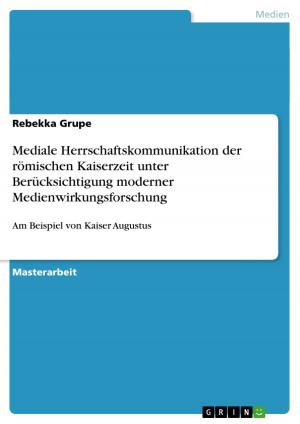The knowledge gap theory of communication
Nonfiction, Reference & Language, Language Arts, Journalism| Author: | Nick Birch | ISBN: | 9783656609438 |
| Publisher: | GRIN Verlag | Publication: | March 5, 2014 |
| Imprint: | GRIN Verlag | Language: | English |
| Author: | Nick Birch |
| ISBN: | 9783656609438 |
| Publisher: | GRIN Verlag |
| Publication: | March 5, 2014 |
| Imprint: | GRIN Verlag |
| Language: | English |
Essay from the year 2013 in the subject Communications - Theories, Models, Terms and Definitions, grade: 1.3, Central Queensland University, course: Applied Communication Arts, language: English, abstract: The Knowledge Gap Theory of Communication is primarily concerned with the unequal distribution of information throughout society and the correlating access to knowledge pertaining to socioeconomic status. The Knowledge Gap Hypothesis was first proposed in 1970 by three University of Minnesota researchers: Phillip J. Tichenor, then Associate Professor of Journalism and Mass Communication, George A. Donohue, Professor of Sociology, and Clarice N. Olien, Instructor in Sociology (Yoo Ri & Southwell, N/A). The hypothesis explains that there is a resulting divide between people of lower and higher socioeconomic status 'as the infusion of mass media information into a social system increases, higher socioeconomic-status segments tend to acquire this information faster than lower socioeconomic-status population segments so that the gap in knowledge between the two tends to increase rather than decrease' (Tichenor, Donohue, and Olien, 1970, p159-160). The resulting speed at which people are able to access tradition mass-media compared to modern systems may be surprisingly congruent when underlying education is taken into consideration.
Nick Birch is a Media Production Professional with a Masters of Creative Enterprise. He has been working in the creative industries since 2000: mainly as an editor for local and international television series, commercials, documentaries, short films, corporate projects and music videos. He also produces, directs, shoots, sound-designs and writes. His extensive experience and natural affinity with clients and their vision makes him a favourite to work with, seeing the return of many satisfied customers. He has worked with TV networks, Hollywood producers, radio stations, mining magnates, airlines, actors, singers, dancers, lawyers, charities, designers, construction, children, animals, sports, tourism and even a volcanologist. He believes in balance, loyalty, freedom, humour and truth-values which permeate his livelihood. His enterprise is to make your story rise and shine in the most admirable, genuine, spectacular and engaging style possible. You can see some of his work at nickbirchstudio.com
Essay from the year 2013 in the subject Communications - Theories, Models, Terms and Definitions, grade: 1.3, Central Queensland University, course: Applied Communication Arts, language: English, abstract: The Knowledge Gap Theory of Communication is primarily concerned with the unequal distribution of information throughout society and the correlating access to knowledge pertaining to socioeconomic status. The Knowledge Gap Hypothesis was first proposed in 1970 by three University of Minnesota researchers: Phillip J. Tichenor, then Associate Professor of Journalism and Mass Communication, George A. Donohue, Professor of Sociology, and Clarice N. Olien, Instructor in Sociology (Yoo Ri & Southwell, N/A). The hypothesis explains that there is a resulting divide between people of lower and higher socioeconomic status 'as the infusion of mass media information into a social system increases, higher socioeconomic-status segments tend to acquire this information faster than lower socioeconomic-status population segments so that the gap in knowledge between the two tends to increase rather than decrease' (Tichenor, Donohue, and Olien, 1970, p159-160). The resulting speed at which people are able to access tradition mass-media compared to modern systems may be surprisingly congruent when underlying education is taken into consideration.
Nick Birch is a Media Production Professional with a Masters of Creative Enterprise. He has been working in the creative industries since 2000: mainly as an editor for local and international television series, commercials, documentaries, short films, corporate projects and music videos. He also produces, directs, shoots, sound-designs and writes. His extensive experience and natural affinity with clients and their vision makes him a favourite to work with, seeing the return of many satisfied customers. He has worked with TV networks, Hollywood producers, radio stations, mining magnates, airlines, actors, singers, dancers, lawyers, charities, designers, construction, children, animals, sports, tourism and even a volcanologist. He believes in balance, loyalty, freedom, humour and truth-values which permeate his livelihood. His enterprise is to make your story rise and shine in the most admirable, genuine, spectacular and engaging style possible. You can see some of his work at nickbirchstudio.com















